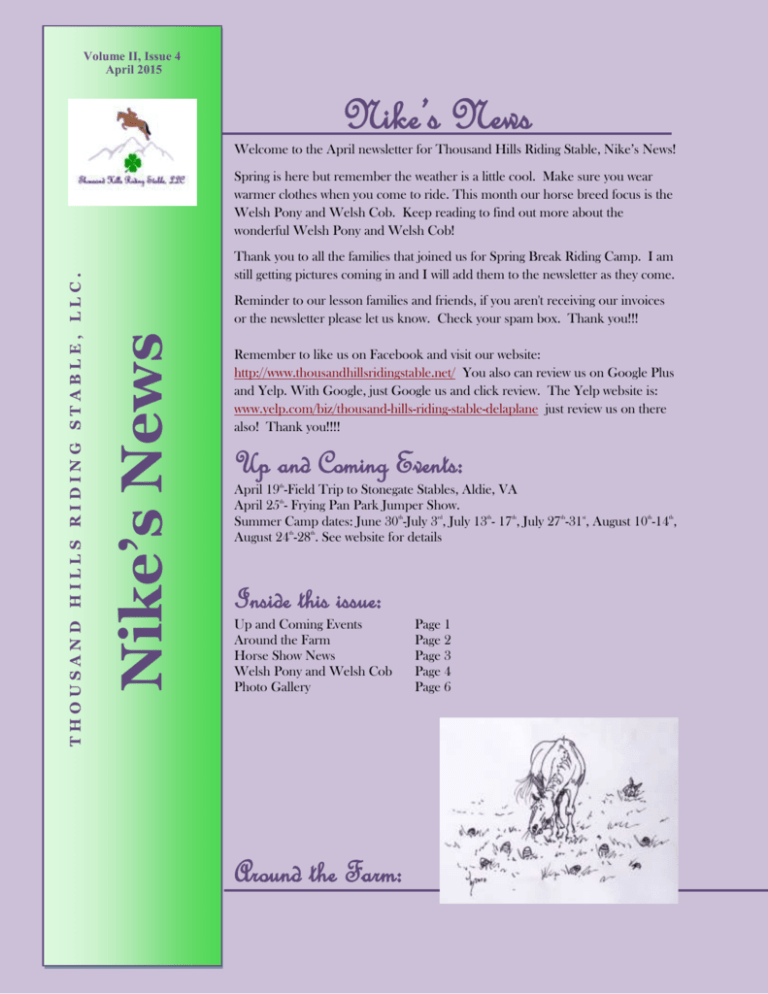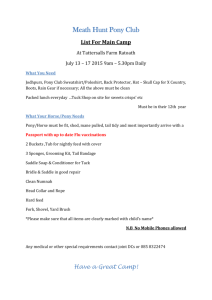- Thousand Hills Riding Stable, LLC
advertisement

Volume II, Issue 4 April 2015 Nike’s News Welcome to the April newsletter for Thousand Hills Riding Stable, Nike’s News! Spring is here but remember the weather is a little cool. Make sure you wear warmer clothes when you come to ride. This month our horse breed focus is the Welsh Pony and Welsh Cob. Keep reading to find out more about the wonderful Welsh Pony and Welsh Cob! THOUSAND HILLS RIDING STABLE, LLC. Thank you to all the families that joined us for Spring Break Riding Camp. I am still getting pictures coming in and I will add them to the newsletter as they come. Nike’s News Reminder to our lesson families and friends, if you aren't receiving our invoices or the newsletter please let us know. Check your spam box. Thank you!!! Remember to like us on Facebook and visit our website: http://www.thousandhillsridingstable.net/ You also can review us on Google Plus and Yelp. With Google, just Google us and click review. The Yelp website is: www.yelp.com/biz/thousand-hills-riding-stable-delaplane just review us on there also! Thank you!!!! Up and Coming Events: April 19th-Field Trip to Stonegate Stables, Aldie, VA April 25th- Frying Pan Park Jumper Show. Summer Camp dates: June 30th-July 3rd, July 13th- 17th, July 27th-31st, August 10th-14th, August 24th-28th. See website for details Inside this issue: Up and Coming Events Around the Farm Horse Show News Welsh Pony and Welsh Cob Photo Gallery Around the Farm: 1 Page 1 Page 2 Page 3 Page 4 Page 6 Welcome to our horseback riding lesson family Jayden, Saylor, Olivia, Maddie and Kate as well as two mom that have decided to ride, Kerri and Karen. Welcome back to the whole Gonzalez family! We are looking forward to having lots of fun with all of you. ***Next Horse Show Field Trip to Stonegate Stables will be April 19th. We will meet at the farm at 9:30 am and leave around 11:00 am.*** We are looking forward to teaching the students what horse showing is all about. As of April 1st lesson prices will increase by $10 to support the many new improvements we will be starting this summer. One of new improvements is a brand new horse trailer. Now we will be able to take more students to horse shows. Our weekend lesson slots are filling up fast, so please contact us soon to reserve your slot. There are more slots open on Saturdays then Sundays. Since April we will start seeing a lot of foals( baby horses) around. Here is some trivia for you all. Name the foals in the pictures below! The answers will be posted in the next newsletter. Horse Show News: Here are the dates for our shows that we will be doing this year. We will also be doing Picturesque Farms Summer Series, dates are TBD. They will be every Wednesday at 3:30pm. 2 Moriah Farm Horse Shows Dates for 2015: Saturdays-Hunters Sundays-Jumper May 9th-Hunter May 10th-Jumper May 30th-Hunter May 31st-Jumper July 25th-Hunter July 26th-Jumper August 1st-Hunter August 2nd-Jumper September 26th-Hunter September 27th-Jumper October 10th-Hunter October 11th-Jumper **April 25th **Ms. Yvonne and Ms Sarah will be attending a Jumper Show at Frying Pan Park. We would love to have cheering section. If you would like to come please let us know and we can give you directions. The Welsh Pony and Welsh Cob The Welsh Pony and Cob are closely related horse breeds including both pony and cob types, which originated in Wales in the United Kingdom. The breed society for the Welsh breeds has four sections, primarily distinguished by height, but also by variations in type: the Welsh Mountain Pony (Section A), the 3 Welsh Pony (Section B), the Welsh Pony of Cob Type (Section C), and the Welsh Cob (Section D). Welsh ponies and cobs are known for their good temperament, hardiness, and free-moving gaits. Native ponies existed in Wales prior to 1600 BC, and a Welsh-type cob was known as early as the Middle Ages. They were influenced by the Arabian horse, and possibly also by the Thoroughbred and the Hackney horse. In 1901, the first stud book for the Welsh breeds was established in the United Kingdom, and in 1907 another registry was established in the United States. Interest in the breed declined during the Great Depression, but revived in the 1950s.Throughout their history, the Welsh breeds have had many uses, including as a cavalry horse, a pit pony, and as a working animal on farms. Today, the modern Welsh Pony and Cob breeds are used for many equestrian competitive disciplines, including showing, jumping and driving, as well as for pleasure riding, trekking and trail riding The smaller types are popular children's ponies. The Welsh also crosses well with many other breeds and has influenced the development of many British and American horse and pony breeds. History: Evidence suggests that a native Welsh-type of pony existed before 1600 BC. The original Welsh Mountain Pony is thought to have evolved from the prehistoric Celtic pony. Welsh ponies were primarily developed in Wales and their ancestors existed in the British Isles prior to the arrival of the Roman Empire. Bands of ponies roamed in a semi-feral state, climbing mountains, leaping ravines, and running over rough moorland terrain. They developed into a hardy breed due to the harsh climate, limited shelter and sparse food sources of their native country. At some point in their development, the Welsh breeds had some Arabian blood added, although this did not take away the physical characteristics that make the breed unique. The Welsh Cob existed as a type as early as the Middle Ages, and mentions of such animals can be found in medieval Welsh literature. During this time period they were known for their speed, jumping ability and carrying capacity. Before the introduction of large, "coldblood" draft horse breeds, they were used for farm work and timbering. In 1485 the Welsh Militia, riding local animals presumed to be ancestors of the modern Welsh Cob, assisted Henry Tudor in gaining the English throne. During the 15th century, similar small horses were also used as rounceys, leading war horses known as destriers. The characteristics of the breeds as they are known today are thought to have been established by the late 15th century, after the Crusaders returned to England with Arabian stallions obtained from the Middle East. In the 16th century, King Henry VIII, thinking to improve the breeds of horses, particularly war horses, ordered the destruction of all stallions under 15 hands and all mares under 13 hands in the Breed of Horses Act 1535. The laws for swingeing culls of 'under-height' horses were partially repealed by a decree by Queen Elizabeth I in 1566 on the basis that the poor lands could not support the weight of the horses desired by Henry VIII because of "their rottenness ... [they] are not able to breed beare and bring forth such great breeds of stoned horses as by the statute of 32 Henry VIII is expressed, without peril of miring and perishing of them", and (fortunately for the future of Britain's mountain and moorland pony breeds) many ponies in their native environments, including the Welsh breeds, therefore escaped the slaughter. On the upland farms of Wales, Welsh ponies and cobs would often have to do everything from ploughing a field to carrying a farmer to market or driving a family to services on Sunday. When coal mining became important to the economy of England, many Welsh ponies were harnessed for use in mines, above and below ground. In the 18th century and 19th century, more Arabian blood was added by stallions who were turned out in the Welsh hills. Other breeds have also been added, including the Thoroughbred, Hackney, Norfolk 4 Roadster, and the Yorkshire Coach Horse. Before the car was developed, the speediest mode of transportation in Wales was the Welsh Cob. Tradesmen, doctors and other businessmen often selected ponies by trotting them the 35 uphill miles from Cardiff to Dowlais. The best ponies could complete this feat in under three hours, never breaking gait. Formal breeding stock licensing was introduced in 1918, but before this, breeding stock was selected by trotting tests like these. In 1901 English and Welsh breeders established a breed registry, called the Welsh Pony and Cob Society, and the first stud book was published in 1902. It was decided that the Welsh Stud Book should be separated into sections divided by type and height. Welsh Ponies were originally only classified as Section A, but in 1931, with the rising demand for riding ponies for children, Section B was added. In the first stud books, the Section B was the Welsh Pony of Cob Type, and the Welsh Cob was Section C and Section D. The upper height limit for Section D Cobs was removed in 1907 and in 1931 Sections C and D were combined as simply Section C. The current standards of Cobs as Sections C and D were finalized in 1949. Until the mid 20th century, the British War Office considered the Welsh Cob so valuable that they paid premiums to the best stallions. After World War II, only three stallions were registered with Section C, but numbers have since recovered. Welsh ponies adapted easily to the terrain and climate variations they encountered when exported to Canada and the United States. They were first exported to the United States as early as the 1880s, and large numbers of animals were exported between 1884 and 1910. The United States registry, also named the Welsh Pony and Cob Society, was incorporated in 1906 and by 1913 a total of 574 ponies had been registered. During the Great Depression, interest in the breed declined, but made a comeback in the 1950s. The population continued to grow, 2,881 ponies had been registered by the end of 1957, and annual studbooks began to be published. All Welsh ponies and cobs in the United States today descend from ponies registered with the UK registry, and over 34,000 have been registered with the US registry as of 2009. 1. 2. 3. pictures of the different type of Welsh Ponies. 1) Section A Welsh Pony, 2) Section B Welsh Pony, 3) Section C Welsh Cob Pony and 4) Section D Welsh Cob. 4. Photo Gallery: 5 Please keep sending your pictures in! We love cute pictures of our kids at the barn or at the horse shows! Please include your child’s first name and the horse or pony they are with. This way we can add them to our monthly newsletter. Please email them to: Yvonne: thrsllc@yahoo.com 6 7 About Thousand Hills Riding Stable: Thousand Hills Riding Stable, LLC 4098 Ashville Road Delaplane, VA 20144 Phone: (540) 364-1124 Email: thrsllc@yahoo.com www.thousandhillsridingsta ble.net Open seven days a week! Hours: 10:00 AM to 7:00PM Don’t forget to like us on Facebook! For more information on price please check out our website. Hope to see you soon! © 2014 Thousand Hills Riding Stable, LLC. 8 Situated in the heart of Northern Virginia Hunt Country and Vineyards in Delaplane, VA. Thousand Hills Riding Stable, LLC. is owned and run by the Toone Family, Mark and Yvonne along with their 2 year old daughter Ariana. Yvonne has gone through Level 2 Certified Horsemanship Association Riding Instructor training and is a licensed Veterinary Technician. Thousand Hills Riding Stable invites riders as young as 2 years old to come explore the art of Horsemanship and Horseback riding. Hope to see you soon! About the editor: Katrina Maddux Katrina has known Mark and Yvonne for several years. Katrina has owned and shown horses since she was 8 years old. She grew up in California and showed on the “A” Hunter Jumper Circuit. She moved to the east coast when she received an Equestrian Scholarship to attend St. Andrews Presbyterian College in North Carolina. There she majored in History with a minor in Equine Science. Katrina currently lives in Hartselle, AL. She owns 2 horses, Abercrombie “Buddy”, 4 year old Oldenburg gelding that she showed in Hunter Breeding in 2013 and will be showing in Baby Green Hunters in 2015. Deardra, Katrina’s other horse is a 9 year old Arabian mare. Katrina shows Deardra in Sport Horse Classes on the Arabian circuit, Amateur Hunters at Hunters shows, and Fox Hunts. She also has 2 dogs, Annie a Standard Schnauzer and a Mini Schnauzer named Pierre. You can email suggestions and photos to Katrina at katrina.silen@gmail.com



